Overview
When a Settlement is complete, Amazon posts a report detailing all payments and deductions for the included orders and initiates a transfer to the merchant’s bank account. Amazon typically settles accounts every 14 days. However, they may not include every order from the specified 14-day period in the new settlement. Sometimes, it can take up to several cycles to settle all orders.
You must import settlement reports from Amazon to maintain accurate Order Profit & Loss records. Importing settlement data allows Sellercloud to automatically apply deductions such as commissions and fees to the orders. Sellercloud only applies deductions to orders that are included in a settlement.
Import Amazon Settlements
You can import Amazon settlement reports into Sellercloud automatically or manually.
Automatically
To import Amazon settlements automatically:
- Go to Company Settings.
- Click Toolbox and select Amazon Settings > General Settings.
- Click Edit.
- Check Enable Settlement Report Download in the Controls panel.
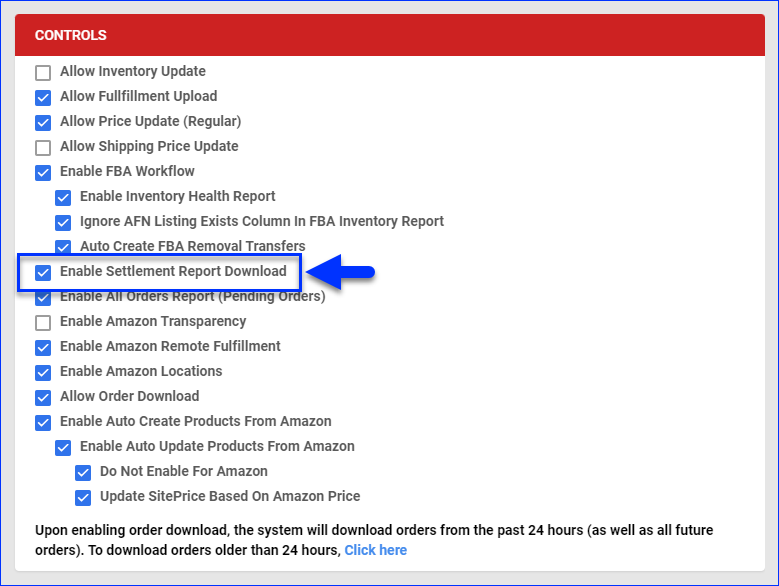
- Click Save.
Request Manually
To manually request a settlement report for a specific time period:
- Go to Company Settings.
- Click Toolbox and select Amazon Settings > Reports.
- Click the Three Dots icon at the top right and select Request New Report.

- Set the Report Type to Settlement V2 Report Data Flat File.
- Choose the From Date and To Date of the settlement period.
- Click Request.
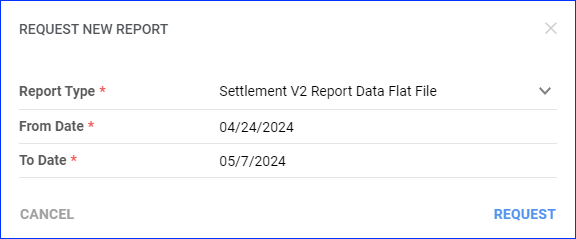
Import From a File
To import Amazon settlements manually:
- Download a settlement report from Seller Central.
- In Sellercloud, go to Company Settings.
- Click Toolbox and select Settlement > Import Settlement.
- Set the Channel to Amazon.
- Click Choose File and select the settlement file.
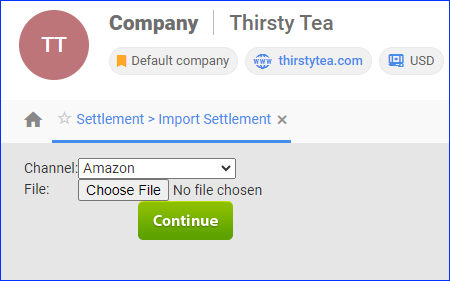
- Click Continue.
View Amazon Settlement Reports
To view a summary and the complete details of a settlement report:
- Go to Company Settings.
- Click Toolbox and select Settlement > Settlement.
- Set the Channel to Amazon.
- You can also use the rest of the filters to refine the results, then click Search. Settlements will appear in a grid with the Start Date, End Date, Deposit Date, and Deposit Amount.
- Click on a Channel Settlement ID to view the full settlement summary and details.
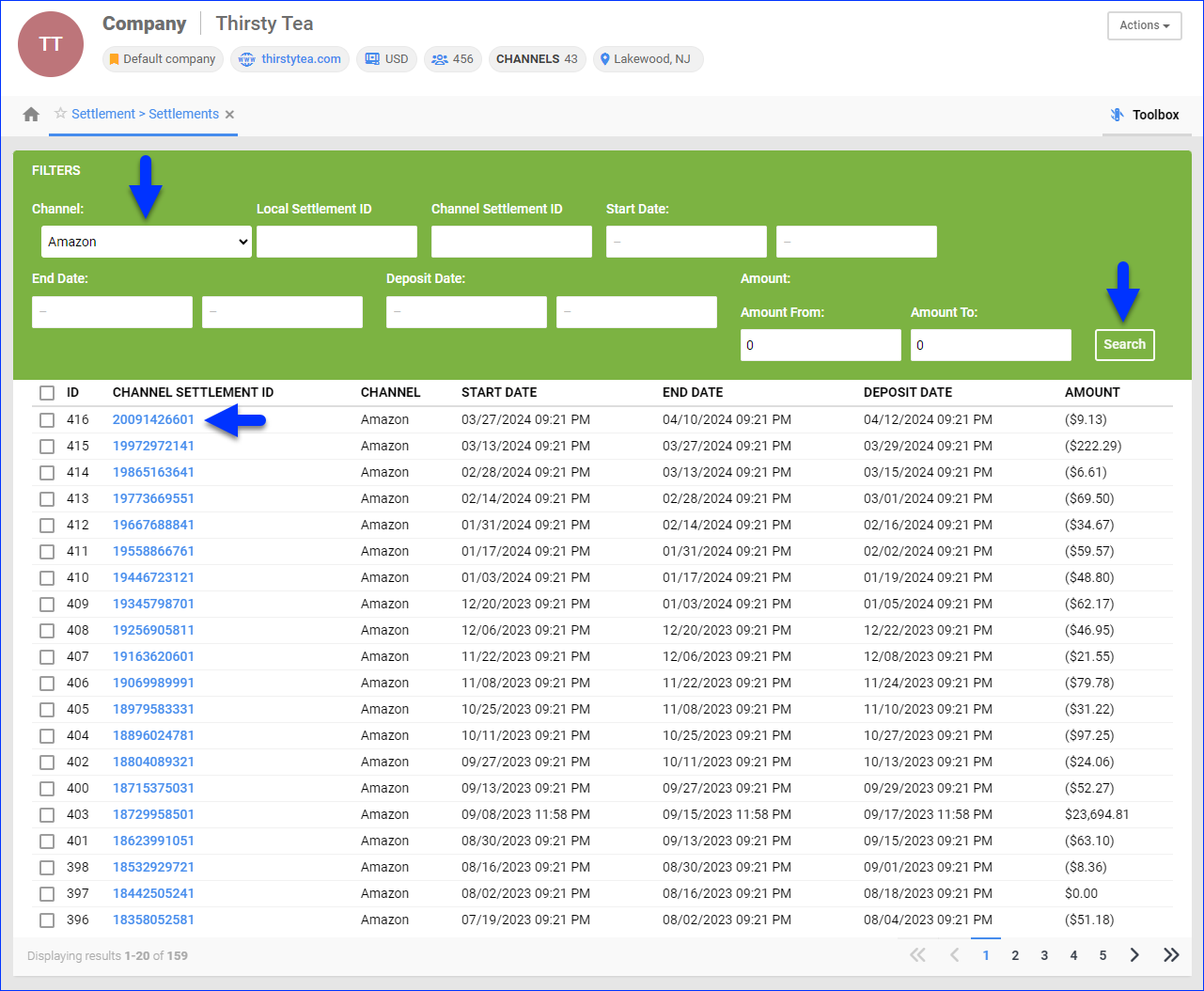
- The settlement details page consists of 4 sections:
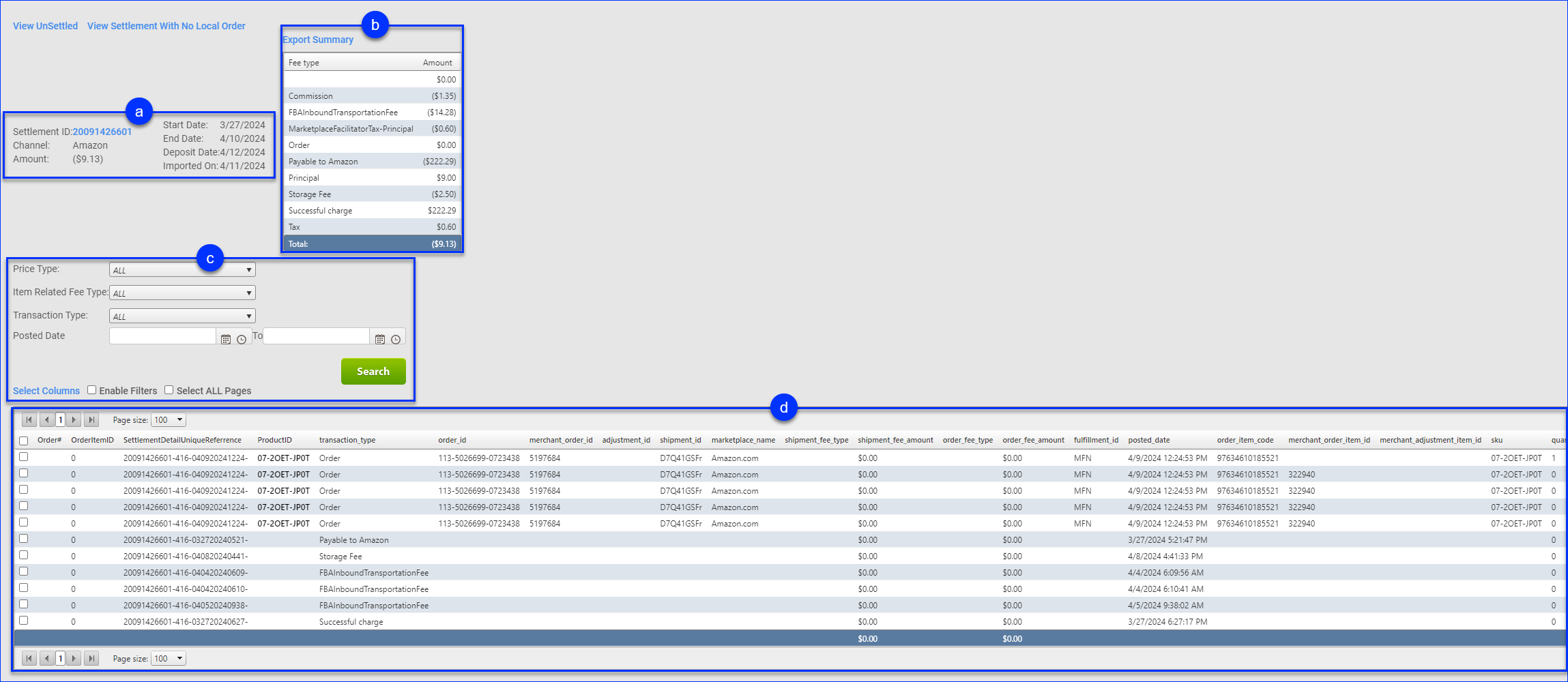
- General details about the settlement.
- A table that summarizes all the fees in the settlement based on fee type.
- Filters that let you see only specific results in the table below.
- A table that shows the complete settlement details of each order.
Amazon Settlement Details
The following sections define the different types of information you can see on the Amazon settlement details page.
Order Types
There are different types of Amazon orders that can be included in settlements:
- Merchant-Fulfilled (MFN)
- Amazon-Fulfilled (AFN)
- Multi-Channel Fulfillment (non-Amazon)
All order types all included in the same settlement report and labeled by their abbreviations under the Fulfillment ID column.
Settlement Data
Settlement data is categorized into four types:
- Transaction Type – Most commonly, this is either an Order or a Refund, but there are many other types, such as Adjustment, Shipping label purchase for return, Payable to Amazon, Storage Fee, FBA Inbound Transportation Fee, and more.
- Price Type – Payment exchanges between the buyer and Amazon.
- Credits to the merchant account, such as Principal, Regulatory Fee, and Shipping.
- Debits to the merchant account, such as Tax, Marketplace Facilitator Tax – Principal, Marketplace Facilitator Regulatory Fee – Principal, and Goodwill.
- Item Related Fee Type – Payment exchanges between Amazon and the seller:
- Debits to the merchant account, such as Commission and FBA fees.
- Credits to the merchant account, such as Refund Commission.
- Shipment Fee Type – Shipping-related fees charged to the merchant. For example, FBA Transportation Fee for orders shipped by FBA (Multi-Channel Fulfillment).
Payments and Credits
Settlements may include payments and credits, such as:
- Principal – The customer’s payment for the base sale price.
- Tax – The tax paid for the Principal.
- Shipping – The customer’s payment for shipping charges.
- Gift Wrap – The customer’s payment for Gift Wrapping.
- Gift Wrap Tax – The tax on the gift wrap price.
- Restocking Fee – A percentage of the item’s price, depending on the type of item and the condition in which it is returned.
Fees and Debits
Settlements may also include fees and debits, such as:
- Commission – Amazon deducts commissions for the item price, gift wrap, and other accessories. See Amazon Commissions for more information.
- Shipping HB – The shipping holdback, a commission on shipping payments.
- FBAPerOrderFulfillmentFee – FBA order handling fee per order.
- FBAPerUnitFulfillmentFee – FBA picking and packing fee per unit.
- FBAWeightBasedFee – FBA weight handling fee.
- FBATransportationFee – Shipping charges for using Amazon’s UPS shipping account to send inventory to the Amazon Fulfillment Center. This fee appears under the Shipment Fee Type column.
- Shipping Chargeback – This debit applies to FBA orders. After Amazon credits your account with the customer’s payment for shipping, the credit is later reversed with the shipping chargeback.
- Gift Wrap Chargeback – This debit applies to FBA orders. After Amazon credits your account with the customer’s payment for gift wrapping, the credit is later reversed with the gift wrap chargeback.
- Restocking Fee Chargeback – This debit applies to FBA orders. After Amazon credits your account with the customer’s payment for the restocking fee, the credit is later reversed with the restocking fee chargeback.
- Goodwill – Compensation that Amazon pays to dissatisfied customers. This charge is debited from the Price Type column.
Overview
When a Settlement is complete, Amazon posts a report detailing all payments and deductions for the included orders and initiates a transfer to the merchant’s bank account. Amazon typically settles accounts every 14 days. However, they may not include every order from the specified 14-day period in the new settlement. Sometimes, it can take up to several cycles to settle all orders.
You must import settlement reports from Amazon to maintain accurate Order Profit & Loss records. Importing settlement data allows Sellercloud to automatically apply deductions such as commissions and fees to the orders. Sellercloud only applies deductions to orders that are included in a settlement.
View Amazon Settlement Reports
- The actual report file is available in Amazon Settings > Reports as the Settlement V2 Data Flat File report.
- On the order’s P&L tab, click the Amazon arrow to open a settlement window to see itemized payments and charges. Hovering over the Shipping Cost value will show a breakdown of shipping costs.
- To view a summary and details of the entire settlement report
- Go to Company Settings > Toolbox > Settlements > Settlements.
- Choose Amazon as the Channel. Select filters if applicable and press Search. Settlements will be displayed in a grid with the Start Date, End Date, Deposit Date, and Deposit Amount.
- Click an Amazon Settlement ID. The settlement summary and details will be displayed in full. The summary summarizes all the fees in the settlement based on Fee Type.
Amazon Settlement Details
The following sections define the different types of information you can see on the Amazon settlement details page.
Order Types
There are different types of Amazon orders that can be included in settlements:
- Merchant-Fulfilled (MFN)
- Amazon-Fulfilled (AFN)
- Multi-Channel Fulfillment (non-Amazon)
All order types all included in the same settlement report and labeled by their abbreviations under the Fulfillment ID column.
Settlement Data
Settlement data is categorized into four types:
- Transaction Type – Most commonly, this is either an Order or a Refund, but there are many other types, such as Adjustment, Shipping label purchase for return, Payable to Amazon, Storage Fee, FBA Inbound Transportation Fee, and more.
- Price Type – Payment exchanges between the buyer and Amazon.
- Credits to the merchant account, such as Principal, Regulatory Fee, and Shipping.
- Debits to the merchant account, such as Tax, Marketplace Facilitator Tax – Principal, Marketplace Facilitator Regulatory Fee – Principal, and Goodwill.
- Item Related Fee Type – Payment exchanges between Amazon and the seller:
- Debits to the merchant account, such as Commission and FBA fees.
- Credits to the merchant account, such as Refund Commission.
- Shipment Fee Type – Shipping-related fees charged to the merchant. For example, FBA Transportation Fee for orders shipped by FBA (Multi-Channel Fulfillment).
Payments and Credits
Settlements may include payments and credits, such as:
- Principal – The customer’s payment for the base sale price.
- Tax – The tax paid for the Principal.
- Shipping – The customer’s payment for shipping charges.
- Gift Wrap – The customer’s payment for Gift Wrapping.
- Gift Wrap Tax – The tax on the gift wrap price.
- Restocking Fee – A percentage of the item’s price, depending on the type of item and the condition in which it is returned.
Fees and Debits
Settlements may also include fees and debits, such as:
- Commission – Amazon deducts commissions for the item price, gift wrap, and other accessories. See Amazon Commissions for more information.
- Shipping HB – The shipping holdback, a commission on shipping payments.
- FBAPerOrderFulfillmentFee – FBA order handling fee per order.
- FBAPerUnitFulfillmentFee – FBA picking and packing fee per unit.
- FBAWeightBasedFee – FBA weight handling fee.
- FBATransportationFee – Shipping charges for using Amazon’s UPS shipping account to send inventory to the Amazon Fulfillment Center. This fee appears under the Shipment Fee Type column.
- Shipping Chargeback – This debit applies to FBA orders. After Amazon credits your account with the customer’s payment for shipping, the credit is later reversed with the shipping chargeback.
- Gift Wrap Chargeback – This debit applies to FBA orders. After Amazon credits your account with the customer’s payment for gift wrapping, the credit is later reversed with the gift wrap chargeback.
- Restocking Fee Chargeback – This debit applies to FBA orders. After Amazon credits your account with the customer’s payment for the restocking fee, the credit is later reversed with the restocking fee chargeback.
- Goodwill – Compensation that Amazon pays to dissatisfied customers. This charge is debited from the Price Type column.